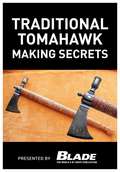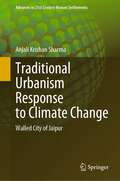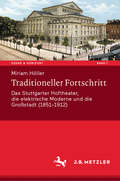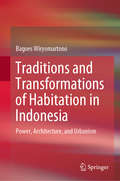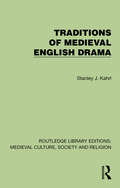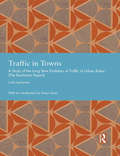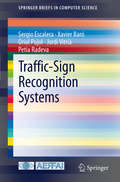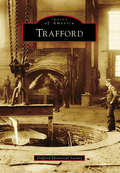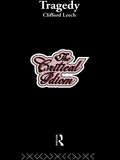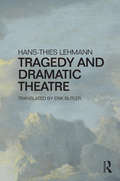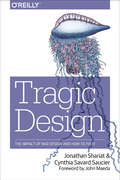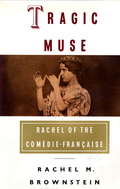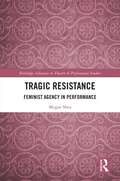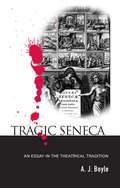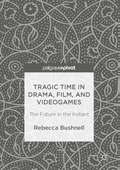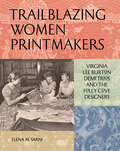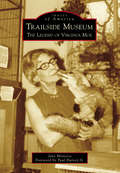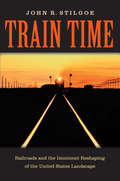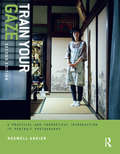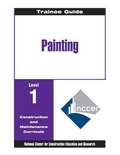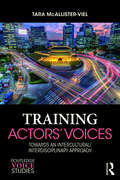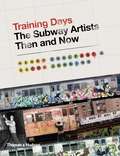- Table View
- List View
Traditional Tomahawk Making Secrets
by Joe KertzmanLearn how Native Americans and early blade smiths fashioned the fierce and fantastic tomahawk. There are fewer cool edged weapons on the planet, says author Joe Szilaski, a regular contributor to BLADE® Magazine and an accomplished knife and tomahawk maker.
Traditional Urbanism Response to Climate Change: Walled City of Jaipur (Advances in 21st Century Human Settlements)
by Anjali Krishan SharmaThe book focuses on the key contemporary issue of Climate change, constructing the narrative from traditions’ of Urbanism through its Axiology and Epistemology. The book is a rich collection of seven chapters and attempts to address each of the aspects and building further for traditional Urbanism. The book further explores the synergies of traditional urbanism for Climate change through climate responsive practices with main thrust on Energy use. The said understanding is validated through the case example of walled city of Jaipur: World Heritage Site 2019. The chapters enumerate how the traditional urbanism of Jaipur was designed that evolved as climate responsive typology for the respective geography.
Traditioneller Fortschritt: Das Stuttgarter Hoftheater, die elektrische Moderne und die Großstadt (1851-1912) (Szene & Horizont. Theaterwissenschaftliche Studien #7)
by Miriam HöllerDie Studie über das Stuttgarter Hoftheater denkt Theater und Stadt zur Zeit der Elektrifizierung um 1900 zusammen. Welchen Einfluss hatte die Theatertechnik auf die werdende Großstadt? Wie wurde umgekehrt das Theater durch die Urbanisierung und Technisierung der Stadt geprägt? Die Studie untersucht anhand historischer Quellen diese Wechselbeziehung über die Analyse neuer räumlich-materieller Vernetzungen. Außerdem analysiert sie kollektive Großstadt-Imaginationen, die zwischen 1902 und 1912 bei der Planung eines Theaterneubaus in Stuttgart aufkamen und die insbesondere über die Architektur und Technik des Theaters verhandelt wurden. Zentral war dabei eine Aushandlung im Spannungsfeld von Tradition und Moderne. So zeigt die Studie, dass auch ein Hoftheater fern der Metropolen als Ort der Moderne erfahren werden konnte, und leistet somit am Schnittpunkt von Theater-, Technik-, Stadt- und Kulturgeschichte einen Beitrag zur Erforschung der Vielfalt des deutschen Theaters um 1900.
Traditions and Transformations of Habitation in Indonesia: Power, Architecture, and Urbanism
by Bagoes WiryomartonoThis book raises the issue of the practice of patrimonial power with a focus on habitations, particularly in the urban areas of Indonesia. An assemblage of interdisciplinary studies within the framework of environmental humanities, covering the arts, architecture, urban studies, geography, cultural anthropology, and sociology, this multifaceted framework divulges the interactive connectivity between Indonesia’s patrimonial culture and the socio-culturally constructed system of habitation. The interdisciplinary study of the pertinent practices of patrimonial power that have been represented and been manifested by various political and traditional regimes in terms of the built environment and habitation in Indonesia contributes to a new understanding of Indonesian urban spatial development, from the pre-colonial era to the present. The book poses that in order to understand the politics of Indonesia, one must understand the culture and tradition of the political leadership of the country. The author presents such an understanding in exploring and unpacking the relationship between people and place that constructs, develops, sustains, and conserves Indonesian culture and traditions of habitation. This book is of interest to graduate scholars and researchers in Asian Studies in numerous disciplines, including urban studies, urban planning and design, political science, architecture, anthropology of space, public administration, and political philosophy.
Traditions of Medieval English Drama (Routledge Library Editions: Medieval Culture, Society, & Religion)
by Stanley J. KahrlOriginally published in 1974, this book examines in detail some of the finest plays from the great cycles of York, Wakefield and Chester. By considering the plays as plays rather than literary relics of a past age, he throws new light both on their aims and intentions as drama and on the intriguing problems of stage techniques. The major morality plays of the period are discussed not only for the interest of their content but for their effectiveness as theatre. Throughout the book the author stresses the richness and strength of a drama which, despite its small corpus of plays, survived as popular drama for several hundred years.
Traffic in Towns: A Study of the Long Term Problems of Traffic in Urban Areas (Studies in International Planning History)
by Colin BuchananTraffic in Towns, also known as the Buchanan Report, is regarded as one of the most influential planning documents of the twentieth century. The report reflected mounting concern about the impact on Britain’s towns and cities of rapid growth in the ownership and use of motor vehicles. Its purpose was to evaluate policy options for reducing the threat of traffic congestion to urban circulation and quality of life. Two main conclusions were drawn from the report: firstly, the need for large-scale reconstruction to make Britain’s cities fit for the ‘motor age’, including split-level megastructures and urban motorways; and secondly, the simultaneous need to preserve parts of the city, especially residential areas as car-free zones or ‘environmental areas’. In Britain, successive governments drew back from implementing the full recommendations of the Study Group, despite initial cross-party support. The prohibitive cost of city-centre redevelopment and motorway construction meant a ‘comprehensive’ solution to the problem of urban traffic on Buchanan lines was never attempted. However, local authorities in a variety of British cities, such as Glasgow, Leicester and Leeds took up aspects of the Report. Internationally, too, the Report had a major impact in countries such as Sweden, Italy and Australia. In the longer term, the influence of the Report may be best judged by the incremental changes it set in train such as pedestrianization of city centres, traffic calming, and other measures linked to Buchanan’s concept of ‘environmental areas’. In focusing attention on the effects of mass motorization on the urban environment Traffic in Towns set the terms of debate for a generation, pre-figuring recent discussion about the car and urban sustainability.
Traffic-Sign Recognition Systems
by Petia Radeva Jordi Vitrià Xavier Baró Oriol Pujol Sergio EscaleraThis work presents a full generic approach to the detection and recognition of traffic signs. The approach is based on the latest computer vision methods for object detection, and on powerful methods for multiclass classification. The challenge was to robustly detect a set of different sign classes in real time, and to classify each detected sign into a large, extensible set of classes. To address this challenge, several state-of-the-art methods were developed that can be used for different recognition problems. Following an introduction to the problems of traffic sign detection and categorization, the text focuses on the problem of detection, and presents recent developments in this field. The text then surveys a specific methodology for the problem of traffic sign categorization - Error-Correcting Output Codes - and presents several algorithms, performing experimental validation on a mobile mapping application. The work ends with a discussion on future research and continuing challenges.
Trafford (Images of America)
by Trafford Historical SocietyTrafford, located in the hills east of Pittsburgh, was officially incorporated as a borough in 1904. John Cavett I and his family were among the first settlers in the area, after purchasing land in 1769. Tracks for the Pennsylvania Railroad were laid through in 1852, and the territory became known as Stewart Station. In 1902, land at Stewart Station was purchased by renowned entrepreneur George Westinghouse, with the purpose of constructing a foundry and town to be named Trafford City, after Trafford Park in Manchester, England. Western Pennsylvania newspapers advertised the sale of lots in Trafford City, and thousands of property seekers came pouring in. The plant thrived for the majority of the 20th century and was the key to Trafford’s growth as a borough. Today, with the plant long gone, Trafford survives as a quaint, community-oriented town with an industrial history that all Pittsburghers can appreciate.
Tragedy (The\critical Idiom Reissued Ser. #1)
by Clifford LeechProfessor Leech considers the significance of the term ‘Tragedy’ as it has been used from classical times to the present day. He gives examples of tragic writing from a wide variety of dramatic literatures and relates theoretical writings on tragedy and the tragedies that have been contemporaneous with them. Free reference is made to critics from Aristotle to these of the present. Special stress is laid on the tragedies of the Greeks, of Renaissance writers and of our immediate contemporaries, notably Harold Pinter and Tom Stoppard. There is also discussion of tragic writing in the modern novel.
Tragedy Walks the Streets: The French Revolution in the Making of Modern Drama
by Matthew S. BuckleyTragedy Walks the Streets challenges the conventional understanding that the evolution of European drama effectively came to a halt during France's Revolutionary era. In this interdisciplinary history on the emergence of modern drama in European culture, Matthew S. Buckley contends that the political theatricality of the Revolution tested and forced the evolution of dramatic forms, supplanting the theater itself as the primary stage of formal development. Drawing on a wide range of texts and images, he demonstrates how the social and political enlistment of dramatic theatricality inflected rising social and political tensions in pre-Revolutionary France, shaped French Revolutionary political culture, conditioned British political and cultural responses to the Revolution, and served as the impetus for Büchner’s radical formal innovations of the 1830s. Setting aside traditional boundaries of literary scholarship, Buckley pursues instead a history of dramatic form that encompasses the full range of dramatic activity in the changing cultural life of the late eighteenth and early nineteenth century, including art, architecture, journalism, political performance, and social behavior. Surveying this expanded field of inquiry, Buckley weaves together a coherent formal genealogy of the drama during this period and offers a new, more continuous generic history of modern drama in its first and most turbulent phase of development.
Tragedy and Dramatic Theatre
by Hans-Thies LehmannThis comprehensive, authoritative account of tragedy is the culmination of Hans-Thies Lehmann’s groundbreaking contributions to theatre and performance scholarship. It is a major milestone in our understanding of this core foundation of the dramatic arts. From the philosophical roots and theories of tragedy, through its inextricable relationship with drama, to its impact upon post-dramatic forms, this is the definitive work in its field. Lehmann plots a course through the history of dramatic thought, taking in Aristotle, Plato, Seneca, Nietzsche, Heidegger, Lacan, Shakespeare, Schiller, Holderlin, Wagner, Maeterlinck, Yeats, Brecht, Kantor, Heiner Müller and Sarah Kane.
Tragic Design: The Impact of Bad Product Design and How to Fix It
by Cynthia Savard Saucier Jonathan ShariatBad design is everywhere, and its cost is much higher than we think. In this thought-provoking book, authors Jonathan Shariat and Cynthia Savard Saucier explain how poorly designed products can anger, sadden, exclude, and even kill people who use them. The designers responsible certainly didn’t intend harm, so what can you do to avoid making similar mistakes?Tragic Design examines real case studies that show how certain design choices adversely affected users, and includes in-depth interviews with authorities in the design industry. Pick up this book and learn how you can be an agent of change in the design community and at your company.You’ll explore:Designs that can kill, including the bad interface that doomed a young cancer patientDesigns that anger, through impolite technology and dark patternsHow design can inadvertently cause emotional painDesigns that exclude people through lack of accessibility, diversity, and justiceHow to advocate for ethical design when it isn’t easy to do soTools and techniques that can help you avoid harmful design decisionsInspiring professionals who use design to improve our world
Tragic Muse
by Rachel BrownsteinThe great nineteenth-century tragedienne known simply as Rachel was the first dramatic actress to achieve international fame. Composing her own persona with the same brilliance and passion she demonstrated on stage, she virtually invented the role of "star. " Rumors of her extravagant life offstage delighted the audiences who flocked to theaters in Boston and Paris, London and Moscow, to see her perform in the tragedies of Racine and Corneille. InTragic Muse, Rachel M. Brownstein reveals the life ofla grande Racheland explores—at the boundary of biography, fiction, and cultural history—the connections between this self-dramatizing woman and her image. Born to itinerant Jewish peddlers in 1821, Rachel arrived on the Paris stage at the age of fifteen. She became both a symbol of her culture’s highest art and a clue to its values and obsessions. Fascinated with all things Napoleonic, she was the mother of Napoleon’s grandson and the lover of many men connected to the emperor. Her story—the rise from humble beginnings to queen of the French state theater—echoes and parodies Napoleon’s own. She decisively controlled her career, her time, and finances despite the actions and claims of managers, suitors, and lovers. A woman of exceptional charisma, Rachel embodied contradiction and paradox. She captured the attention of her time and was memorialized in the works of Matthew Arnold, Charlotte Brontë, George Eliot, and Henry James. Richly illustrated with portraits, photographs, and caricatures,Tragic Musecombines brilliant literary analysis and exceptional historical research. With great skill and acuity, Rachel M. Brownstein presents Rachel—her brief intense life and the image that was both self-fashioned and, outliving her, fashioned by others. First published by Knopf (1993), this book will attract a broad audience interested in matters as wide ranging as the construction of character, the cult of celebrity, women’s lives, and Jewish history. It will also be of enduring interest to readers concerned with nineteenth-century French culture, history, literature, theater, and Romanticism. Tragic Musewon the 1993 George Freedley Award presented by the Theater Library Association.
Tragic Resistance: Feminist Agency in Performance (Routledge Advances in Theatre & Performance Studies)
by Megan SheaTragic Resistance analyzes playwrights, directors, and performers who shatter gender norms to gain agency within the patriarchal institutions restricting them.The artists in this book work against the tragic narratives that would otherwise constrict them: the tragedy of Antigone unmade by Judith Malina, the history of "The Venus Hottentot" pulled into the present in Suzan-Lori Parks's Venus, the narrative of the rape "victim" eschewed in Emma Sulkowicz's performances, the story of brides jilted by the homophobic state government in the case of Annie Sprinkle and Beth Stephens, the tragedy of Anna Nicole as told by Margaret Cho, and the reclamation of the female body from traditional hip hop by Nicki Minaj. All these performers and performances subvert traditional notions of gendered roles that people should or could hold.This book examines the nature of these performances to interrogate how theatrical and performative resistance works and why performance might be a vehicle for altering patriarchal structures that withhold agency from women and trans/genderqueer+ people.
Tragic Seneca: An Essay in the Theatrical Tradition
by A. J. BoyleTragic Seneca undertakes a radical re-evaluation of Seneca's plays, their relationship to Roman imperial culture and their instrumental role in the evolution of the European theatrical tradition.Following an introduction on the history of the Roman theatre, the book provides a dramatic and cultural critique of the whole of Seneca's corpus, analysing the declamatory form of the plays, their rhetoric, interiority, stagecraft and spectacle, dramatic, ideological and moral structure and their overt theatricality. Each of Seneca's plays is examined in detail, locating the force of Senecan drama not only in the moral complexity of the texts and their representations of power, violence, history, suffering and the self, but the semiotic interplay of text, tradition and culture.The later chapters focus on Seneca's influence on Italian, English and French drama of the Renaissance. A.J. Boyle argues that tragedians such as Cinthio, Kyd, Marlowe, Shakespeare, Webster, Corneille, and Racine owe a debt to Seneca that goes beyond allusion, dramatic form and the treatment of tyranny and revenge to the development of the tragic sensibility and the metatheatrical mind.Tragic Seneca attempts to restore Seneca to a central position in the European literary tradition. It will provide readers and directors of Seneca's plays with the essential critical guide to their intellectual, cultural and dramatic complexity.
Tragic Time in Drama, Film, and Videogames
by Rebecca BushnellThis book explores how classical and Shakespearean tragedy has shaped the temporality of crisis on the stage and in time-travel films and videogames. In turn, it uncovers how performance and new media can challenge common assumptions about tragic causality and fate. Traditional tragedies may present us with a present when a calamity is staged, a decisive moment in which everything changes. However, modern performance, adaptation and new media can question the premises of that kind of present crisis and its fatality. By offering replays or alternative endings, experimental theatre, adaptation, time travel films and videogames reinvent the tragic experience of irreversible present time. This book offers the reader a fresh understanding of tragic character and agency through these new media's exposure of the genre's deep structure.
Trailblazing Women Printmakers: Virginia Lee Burton Demetrios and the Folly Cove Designers
by Elena M. SarniA visual history of the Folly Cove Designers (1941-1969)—one of America's longest-running block printing collectives.The Folly Cove Designers (officially 1941-1969) was a grassroots collective of predominantly women block printers founded by Caldecott Award-winner and beloved children's book author/illustrator Virginia Lee Burton Demetrios (of Mike Mulligan and His Steam Shovel fame).This trailblazing Gloucester, MA–based group produced more than three hundred distinct designs, which they block printed on fabric. The designs conveyed personal and regional narratives through the use of shared design principles and the compelling language of pattern. The group was propelled to international fame through commercial contracts with major retailers (F. Schumacher, Lord & Taylor, etc.), articles in leading periodicals such as Life, and participation in seminal fine craft exhibitions. Their work continues to inspire contemporary printmakers around the globe, particularly women printmakers.As the first comprehensive history of the Folly Cove Designers, Trailblazing Women Printmakers documents and celebrates the group's tremendous success and the incredible artistry of its members. With more than 250 black-and-white and color photographs, author Elena M. Sarni explores the Folly Cove Designers' history, work, and group dynamics.
Trailerama: 1000 Piece Puzzle
by Phil NoyesPhotos, postcards, and ads featuring vintage trailers—from humble family vacations to Hollywood stars. Trailerama provides a visual wonderland filled with imagery featuring these vintage vehicles, fondly recalled for their associations with fun, adventure, family vacations—and of course, movie stars on the set. From greeting cards to postcards to Hollywood photos, the travel trailer is put on grand display in this kitschy celebration culled from the coffers of Trailer Travel&’s Phil Noyes. &“Filled with colorful images of trailers. Culled from ads, postcards, sheet music, and more, they run the gamut from the earliest mobile coaches in the 1930s to the roving behemoths that came to dominate the market in later decades…Noyes documents the country&’s still smoldering love affair with life on the road.&”—Los Angeles Magazine
Trails for the Twenty-First Century: Planning, Design, and Management Manual for Multi-Use Trails
by Kristine Olka Robert Rails to Trails Conservancy Charles Flink David Burwell Robert SearnsCommunities across the country are working to convert unused railway and canal corridors into trails for pedestrians, cyclists, horseback riders, and others, serving the needs of both recreationists and commuters alike. These multi-use trails can play a key role in improving livability, as they offer an innovative means of addressing sprawl, revitalizing urban areas, and reusing degraded lands. Trails for the Twenty-First Century is a step-by-step guide to all aspects of the planning, design, and management of multi-use trails. Originally published in 1993, this completely revised and updated edition offers a wealth of new information including. *discussions of recent regulations and federal programs, including ADA and TEA-21 *recently revised design standards from AASHTO *current research on topics ranging from trail surfacing to conflict resolution *information about designing and building trails in brownfields and other *environmentally troubled landscapes Also included is a new introduction that describes the importance of rail-trails to the sustainable communities movement, and an expanded discussion of maintenance costs. Enhanced with a wealth of illustrations, Trails for the Twenty-First Century provides detailed guidance on topics such as: taking a physical inventory and assessment of a site; involving the public and meeting the needs of adjacent landowners; understanding and complying with existing legislation; designing, managing, and promoting a trail; and where to go for more information. It is the only comprehensive guidebook available for planners, landscape architects, local officials, and community activists interested in creating a multi-use trail.
Trailside Museum: The Legend of Virginia Moe
by Paul Harvey Jr. Jane MoroccoOn October 8, 1930, Charles "Cap" Sauers, general superintendent of the Cook County Forest Preserve District, wrote a letter to Alfred M. Bailey, director of the Chicago Academy of Sciences, about an idea he had. He proposed developing several nature study museums with the support of Bailey and the Academy of Sciences. Bailey eagerly wrote to Sauers that he had the Academy's full cooperation. By 1932, the Trailside Museum of Natural History was opened in River Forest, Illinois, the first of its kind in the Midwest. Several curators would come and go, but one in particular, Virginia Moe, dedicated more than 50 years of her life to the museum, animals, and people of Cook County. This is truly her story.
Train Time: Railroads and the Imminent Reshaping of the United States Landscape
by John R. StilgoeUnlike many United States industries, railroads are intrinsically linked to American soil and particular regions. Yet few Americans pay attention to rail lines, even though millions of them live in an economy and culture "waiting for the train." In Train Time: Railroads and the Imminent Reshaping of the United States Landscape, John R. Stilgoe picks up where his acclaimed work Metropolitan Corridor left off, carrying his ideas about the spatial consequences of railways up to the present moment. Arguing that the train is returning, "an economic and cultural tsunami about to transform the United States," Stilgoe posits a future for railways as powerful shapers of American life. Divided into sections that focus on particular aspects of the impending impact of railroads on the landscape, Train Time moves seamlessly between historical and contemporary analysis. From his reading of what prompted investors to reorient their thinking about the railroad industry in the late 1970s, to his exploration of creative solutions to transportation problems and land use planning and development in the present, Stilgoe expands our perspective of an industry normally associated with bad news. Urging us that "the magic moment is now," he observes, "Now a train is often only a whistle heard far off on a sleepless night. But romantic or foreboding or empowering, the whistle announces return and change to those who listen." For scholars with an interest in American history in general and railroad and transit history in particular, as well as general readers concerned about the future of transportation in the United States, Train Time is an engaging look at the future of our railroads.
Train Your Gaze: A Practical and Theoretical Introduction to Portrait Photography
by Roswell AngierFocusing on the presence of the photographer’s gaze as an integral part of constructing meaningful images, Roswell Angier combines theory and practice, to provide you with the technical advice and inspiration you need to develop your skills in portrait photography.Fully updated to take into account advances in creative work and photographic technology, this second edition also includes stunning new visuals and a discussion on the role of social media in the practice of portraiture.Each chapter includes a practical assignment, designed to help you explore various kinds of portrait photography and produce a range of different styles for your creative portfolio.
Trainee Guide Painting Level 1
by Research National Center for Construction EducationPainting: Trainee Guide Level 1: Commercial and Residential
Training Actors' Voices: Towards an Intercultural/Interdisciplinary Approach (Routledge Voice Studies)
by Tara McAllister-VielContemporary actor training in the US and UK has become increasingly multicultural and multilinguistic. Border-crossing, cross-cultural exchange in contemporary theatre practices, and the rise of the intercultural actor has meant that actor training today has been shaped by multiple modes of training and differing worldviews. How might mainstream Anglo-American voice training for actors address the needs of students who bring multiple worldviews into the training studio? When several vocal training traditions are learned simultaneously, how does this shift the way actors think, talk, and perform? How does this change the way actors understand what a voice is? What it can/should do? How it can/should do it? Using adaptations of a traditional Korean vocal art, p’ansori, with adaptations of the "natural" or "free" voice approach, Tara McAllister-Viel offers an alternative approach to training actors’ voices by (re)considering the materials of training: breath, sound, "presence," and text. This work contributes to ongoing discussions about the future of voice pedagogy in theatre, for those practitioners and scholars interested in performance studies, ethnomusicology, voice studies, and intercultural theories and practices.
Training Days: The Subway Artists Then and Now
by Sacha Jenkins Henry ChalfantAuthentic first-person accounts from the graffiti artists whose creative genius fueled the movement from its beginning in late 1970s and early 1980s New York Late 1970s New York City was bankrupt and its streets dirty and dangerous. But thecity had a wild, raw energy that made it the crucible for the birth of rap culture and graffiti. Graffiti writers worked in extremely tough conditions: uncollected garbage, darkness, cramped spaces, and the constant threat of police raids, assault by security staff and attacks by rival crews. It was not unlike practicing performance art in a war zone. Yet during the fertile years of the late 1970s and 1980s they evolved their art from stylized signatures to full-blown Technicolor dreamscapes. Henry Chalfant created panoramic images of painted trains by photographing overlapping shots along the train's length. It took time to earn the writers' trust andrespect, but Chalfant became their revered confidant and with Tony Silver went on to produce the classic documentary film Style Wars (1983). Through a series of interviews conducted by Sacha Jenkins, we hear the voices of these characters of old New York. Quite a few of the original writers are no longer with us, but those who have survived have continued to push the envelope as artists and individuals in a new millennium.The stories they tell, included here alongside iconic, raw photographs of their work, will enthrall graffiti fans everywhere.
